Sha‘ar ha-Golan
EXCAVATIONS
Two small-scale excavation seasons were conducted at Sha‘ar ha-Golan in 1989 and 1990, and eight large-scale excavation seasons in 1996–2003. All were under the direction of Y. Garfinkel, on behalf of the Institute of Archaeology of the Hebrew University of Jerusalem. Four new areas (E–H) were excavated, reaching a combined area of c. 2,500 sq m. The numbering of the excavation areas continues M. Stekelis’ sequence.
EXCAVATION RESULTS
AREA E. Area E is located on the bank of the Yarmuk River, at the center of the ancient settlement. The new expedition exposed c. 1,800 sq m in this area, discovering a number of large courtyard buildings and a network of streets. Two of the buildings, I and II, were entirely exposed.
Building I consists of a triangular central courtyard surrounded by eight rooms. It was constructed using a simple building technique. The walls were built without foundation trenches directly upon the ground surface, their lower part of rounded basalt river pebbles, over which rounded mud bricks were laid. The entrance to the central courtyard is from an open area between buildings to the south. Small rooms enclose the courtyard on all sides. In the southwestern corner is a round room; the others are rectangular or square in shape. Five of the rooms have beaten earth floors and three, apparently storage rooms, are paved with flat basalt river pebbles. The considerable size of the building and the arrangement of the rooms with adjacent storage indicate that an extended family, probably consisting of four nuclear families, lived in the building.
Building II, located in the western part of area E, extends c. 35 m from north to south, and is 20 m wide along an east–west axis. Its total area is c. 700 sq m. It is the largest Neolithic period building uncovered to date in the ancient Near East. It consists of a large courtyard surrounded by approximately 24 rooms. Some of the rooms are paved with river pebbles and appear to have been utilized for storage. In the corner of one of the rooms was found a large silo jar that stood buried below floor level. In the open courtyard were found various installations, including pits, stone pavements, mud plaster, and four large basalt mortars. Roughly 70 figurines of a variety of different types were found in the building. They are made of fired clay or engraved limestone river pebbles. This is the largest concentration of artistic objects ever found in a single prehistoric building.
The earliest network of streets in Israel was found in area E. It includes a narrow alley and a straight street leading from the inside of the settlement to the banks of the Yarmuk River. The alley, c. 1 m wide, is paved in tamped earth and follows a winding path for 15 m. The street, 3 m wide, consists of layers of small river pebbles mixed with mud plaster. Several such layers were found superimposed and attest to periodic renewal of the street surface.
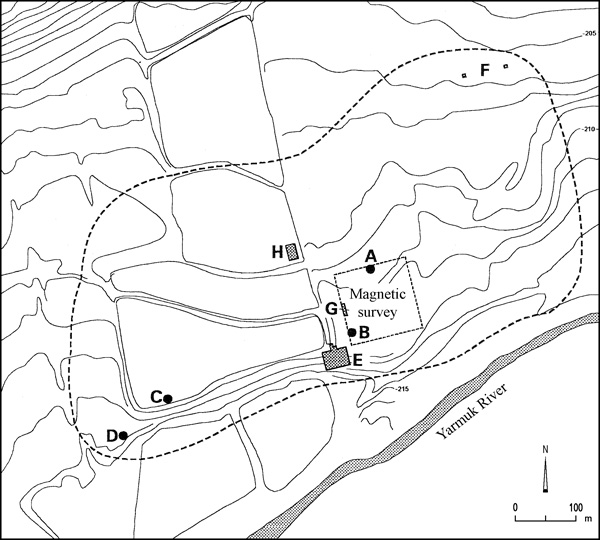
AREA F. Area F is located at the northeastern end of the site. Numerous finds had been brought to the surface in this area as a consequence of deep plowing; subsequently, two small probes, 30 m apart, were excavated. In each of these probes, remains of thick stone walls were found, attesting to large buildings, similar to those found in area E.
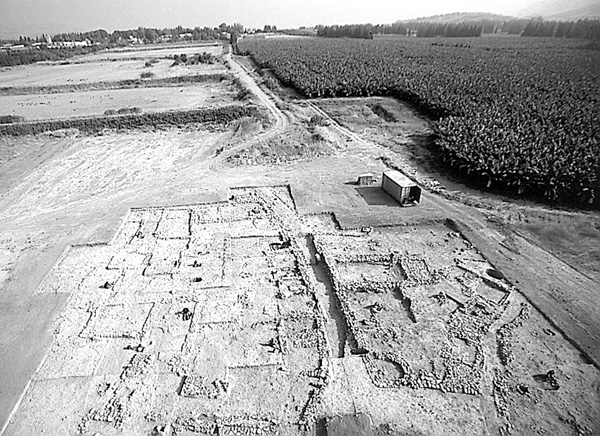
AREA G. A test trench measuring 20 by 5 m was excavated from the surface to virgin soil, lying at a depth of up to 3 m. At the base of the section are Lissan Formation
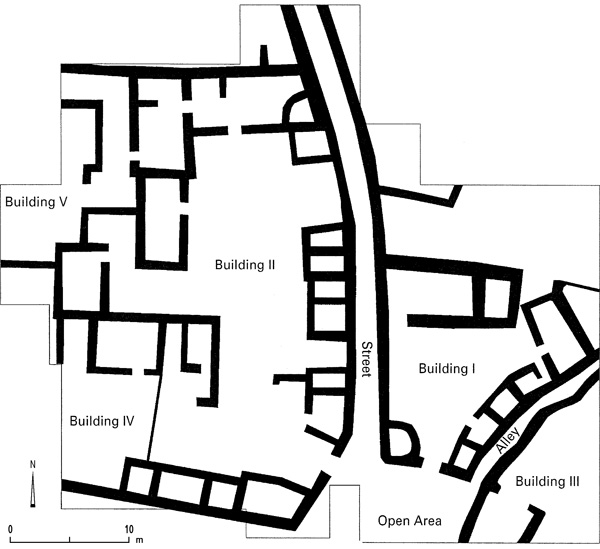
AREA H. Area H represents a portion of the ancient settlement located far from the banks of the Yarmuk, approximately 300 m north of area E. In the course of three seasons c. 700 sq m were excavated in the area, including a street and a large courtyard house with a central courtyard surrounded by 10 rooms. In one of these rooms was found a large silo jar sunken into the floor.
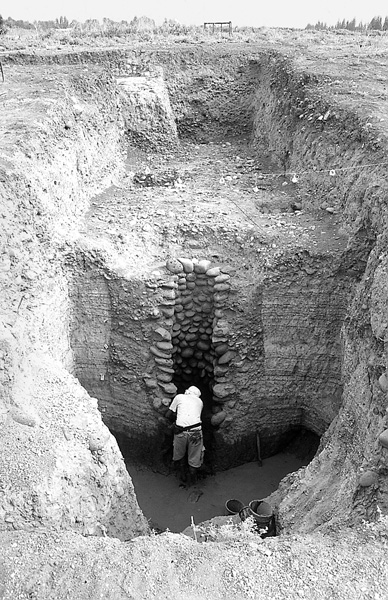
THE FINDS. An unusually large and diverse corpus of finds was uncovered at Sha‘ar ha-Golan, including pottery, flint tools, and stone tools. The major innovation of the Yarmukian culture was the production of pottery vessels for the first time in the region. These vessels occur in a variety of forms and sizes, their outstanding feature being a herringbone pattern incised on the vessel surface before firing. Hundreds of thousands of flint artifacts were also collected during the excavation. The majority of these consist of debitage, including cores, flakes, blades, and chips. Three groups of tools typical of this period are arrowheads, sickle blades, and axes. Some 1,000 stone tools made of basalt and limestone were unearthed. The main group consists of mortars, pestles, grinding stones, bowls, weights, sharpeners, and hammerstones. Roughly 10 obsidian artifacts have been found at Sha‘ar ha-Golan, attesting to trade links with distant regions of the ancient Near East. Several dozen seashells and a few beads were also discovered.
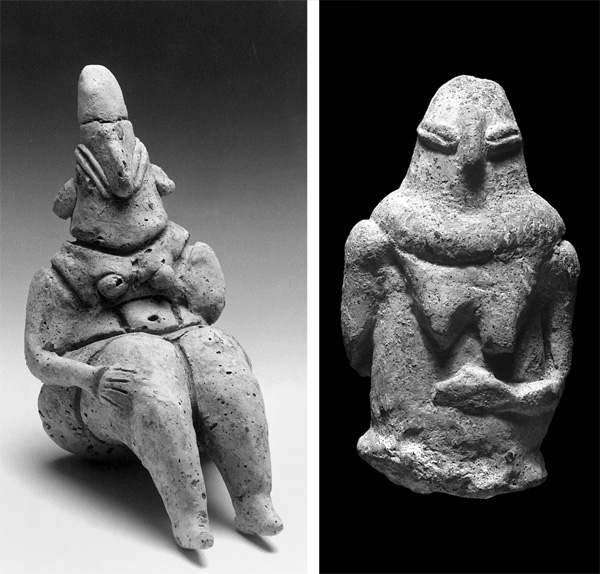
THE ART OBJECTS. Over 300 art objects have been collected and excavated at the site. The quality of the sculpture and the level of design of the objects are noteworthy and reflect conceptual sophistication and a high level of abstraction. One type is the female figurine with coffee-bean eyes. They are broad, large figurines depicting a seated female, highly stylized and detailed, and quite uniform as a group. The design is realistic, tending towards exaggerated. Noteworthy features are the elongated head, slanted eyes with lengthwise groove, prominent hips, and substantial fat folds. Another figurine type, over 100 of which have been found, is a schematic representation of the human form carved on limestone river pebbles. Five pillar figurines, c. 5 cm tall, were also discovered; they are cylindrical with flat bases, enabling them to be freestanding. Facial characteristics—eyes, nose, mouth, and ears—are emphasized, while other parts of the body are ignored. Other types of figurines are clay cylinders, carved representations of humans in stone, animal figurines, and grooved basalt pebbles. In addition to the figurines, a number of seals (all surface finds) are known from the site. One of these is a button seal bearing an incised radial design. The rich and varied assemblage of art objects from Sha‘ar ha-Golan raises numerous questions, such as why such a large number of art objects would be concentrated at this particular site, why 80 objects were recovered in a single building, what the function and significance of these figurines could have been in Neolithic society, why female figurines predominate, and if a functional difference exists between the pebble and clay figurines.
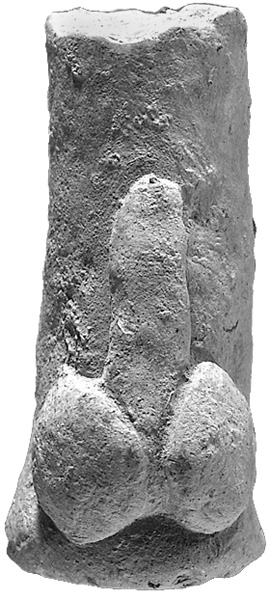
SUMMARY
Prior to the renewed excavations at Sha‘ar ha-Golan, it had generally been accepted that there was a break in the archaeological continuity of Israel in the Pottery Neolithic period, during which the entire region was thought to have been settled only by nomadic pastoral groups who lived in pit dwellings in seasonal encampments. This view has now changed entirely. The large settlement at Sha‘ar ha-Golan extends over a 50-a. area and includes a network of streets, large courtyard houses, a water supply from wells, and abundant art objects. It is now clear that Sha‘ar ha-Golan was a major Near Eastern cultural center during the Pottery Neolithic period.
YOSEF GARFINKEL
Color Plates
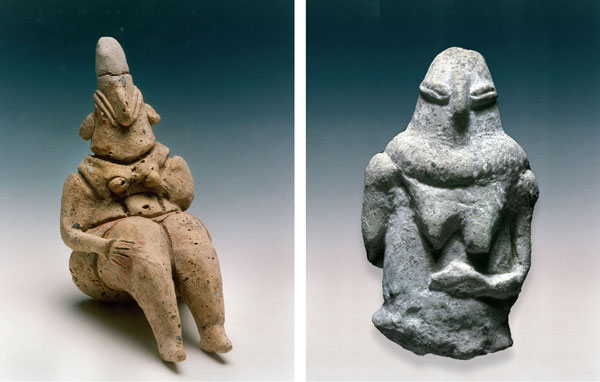
EXCAVATIONS
Two small-scale excavation seasons were conducted at Sha‘ar ha-Golan in 1989 and 1990, and eight large-scale excavation seasons in 1996–2003. All were under the direction of Y. Garfinkel, on behalf of the Institute of Archaeology of the Hebrew University of Jerusalem. Four new areas (E–H) were excavated, reaching a combined area of c. 2,500 sq m. The numbering of the excavation areas continues M. Stekelis’ sequence.
EXCAVATION RESULTS
AREA E. Area E is located on the bank of the Yarmuk River, at the center of the ancient settlement. The new expedition exposed c. 1,800 sq m in this area, discovering a number of large courtyard buildings and a network of streets. Two of the buildings, I and II, were entirely exposed.
